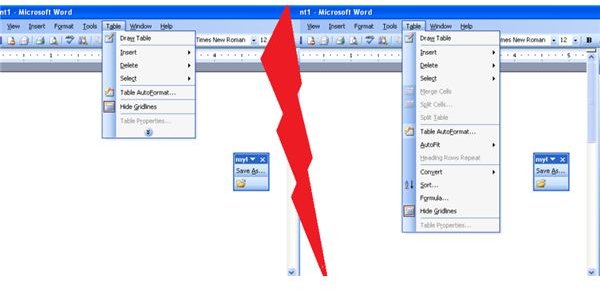Why Do My Office 2003 Menus Change?
Office 2003 - Still in Use Ten Years on
Despite being released in 2002, Office 2003 is still in use quite widely around the world. Commonly found in organizations and corporations where a complete roll out of newer software isn’t possible or practical (perhaps due to budgetary, infrastructure, location or hardware issues) this older version of Office nevertheless includes plenty of top features across the main applications of Outlook, Word, Excel, PowerPoint and Access.
In fact, you might be hard pushed to find any compelling reason for upgrading to 2007 or 2010, which is why 2003 remains in use.
This is not to say Office 2003 is perfect, however. From time to time, its various quirks are on display for all to see, such as the question of its menu system. You may or may not have noticed, but the menus in Office 2003 tend to change with some regularity. Whether you’re looking for a command on the main drop-down menus or a button on the toolbar, you might encounter some difficulty.
Why the Menus Change
The reason that the menus change in Office 2003 is simple – there are simply too many options to be displayed within the existing on-screen real estate afforded by the operating system. This is an extension of the concept delivered in Office 2000, whereby only the most popular menu items would be displayed when the relevant menu button was pressed. On the toolbar you will find a similar usage-based auto-customization occurring, a trick conceived by Microsoft to allow users to quickly find the tools that they use regularly.
Let’s take the Tools drop-down menu in Office 2003 as an example; you will find that the initial view of the functions available in Tools is quite limited, but that there is also an arrow at the bottom of the menu. By either clicking this arrow or double-clicking the Tools menu header you can expand the menu to display the full wealth of functions and tools that are available. The more compact menu will save time, and as you use it more and more it will tailor itself only to feature the tools that you use regularly when you first open it, with the remainder of tools appearing when the arrow is used.
While the method might be restricting to certain users looking for barely-used features, it is by-and-large a successful tool for managing the desktop restrictions. If we consider that back in 2002/2003 (when this version of Office was released) monitors had a much smaller average resolution than they do now, then you can see why this method was employed, just as you might see why later versions of Office employed the “ribbon” toolbar that groups features and functions together, also based on how much they might be used.
Managing the Most Recently Used Menus
Menus that are automatically tailored to your requirements are a pretty cool idea, and one that is reasonably well executed, but not every user is keen on it. As far as the toolbar functions and menus go, you might prefer to have them at your fingertips at all times rather than have to go scrabbling around looking for them. For instance, in Microsoft Word, you might like to know where the Insert Table command is, and be comfortable opening the required menu and finding it in the expected place.
There are a couple of ways around this. The first is to disable the “auto-hide menus” in the options of the application you are using. Simply right-click on the toolbar and select Customize… > Options and check the Always show full menus setting.
It is also via the Customize box, on the Toolbars tab, that a custom menu can be created using the Add button. After naming the custom option, you can switch to the Commands tab to find the menu items that you wish to feature on your new toolbar, and these can be added by left-click and dragging them to the menu. Options are arranged by the appropriate menu heading that you found find them under, so they should be easy to find and add.
Making the Right Choice
If you don’t want to use the tailored auto-hide menus and have opted to use the full menus, you should bear in mind that a considerable wealth of options will be available – perhaps too many. As such, you might opt to undo the Always show full menus setting.
Meanwhile, if you find that the most recently used choices that are being displayed aren’t really relevant, you can discard these with the Customize… > Options > Reset menu and toolbar usage data button.
Finally, if you decide that you don’t want to use your own custom menu anymore, this can be closed using the X in the top corner of the menu, and deleted entirely via Customize > Toolbars, where the Delete button should be used with the appropriate menu selected.
References
Author’s own experience.
Screenshots provided by author.
